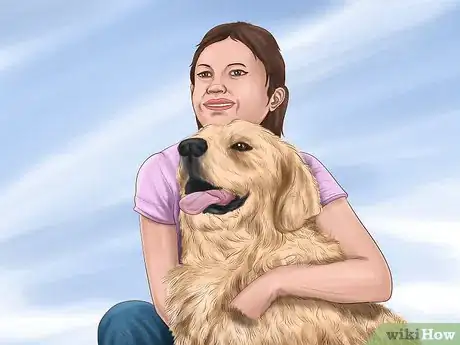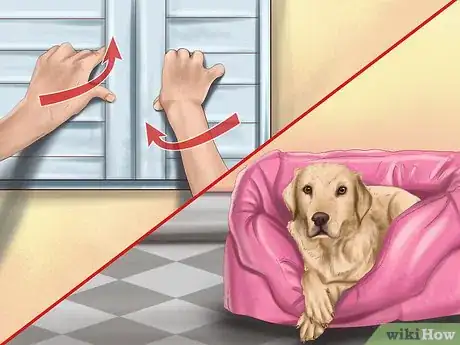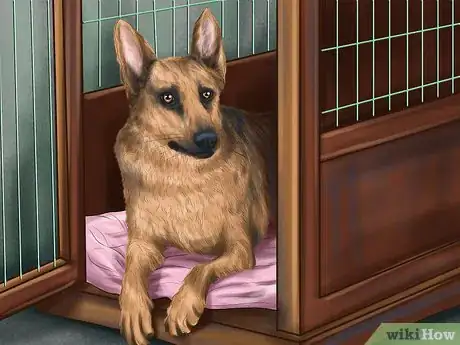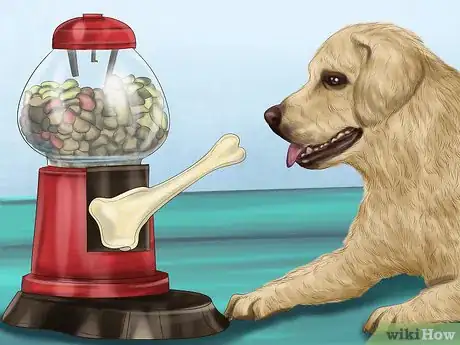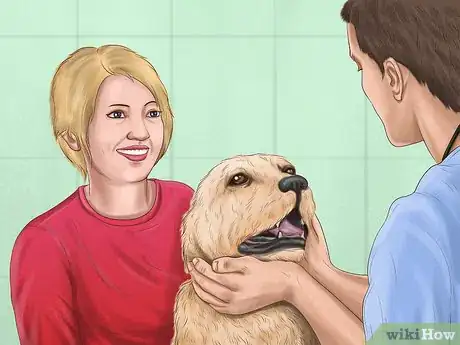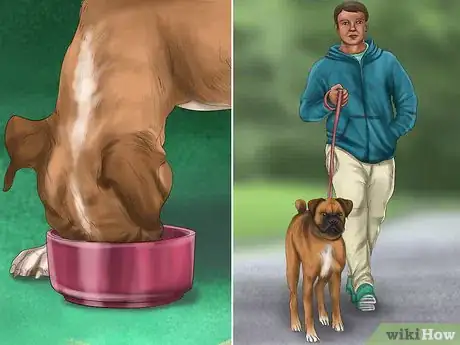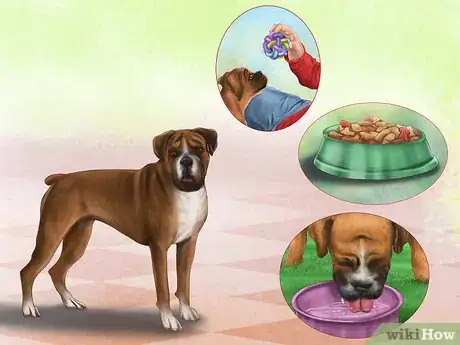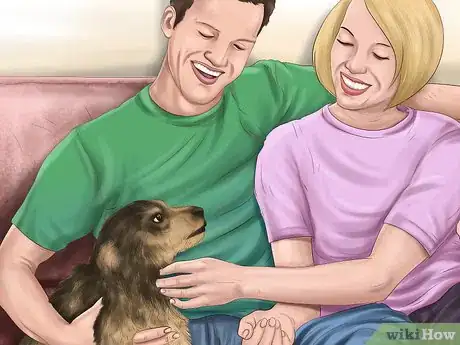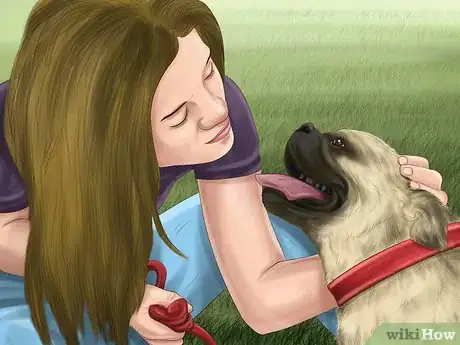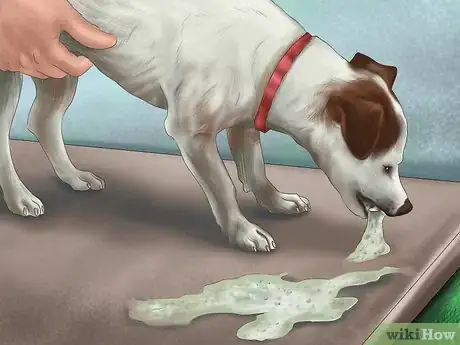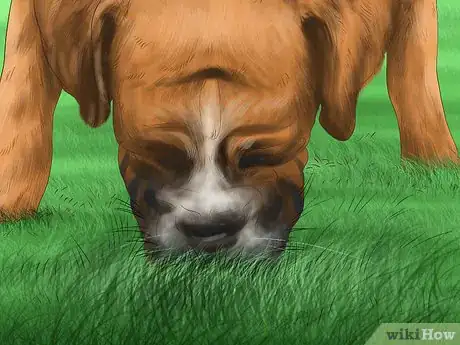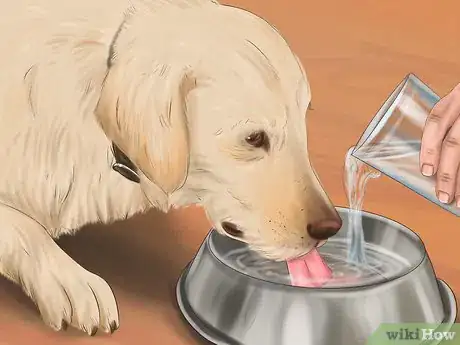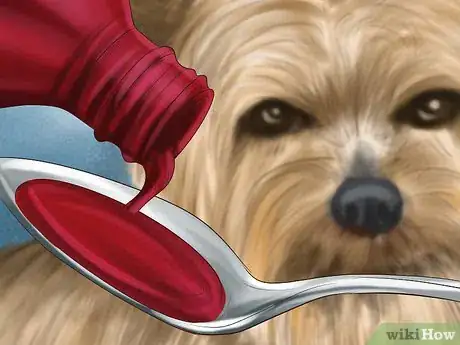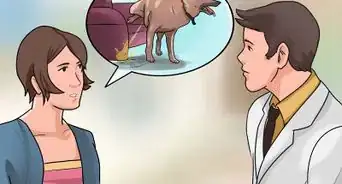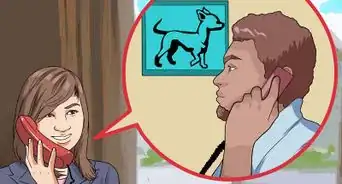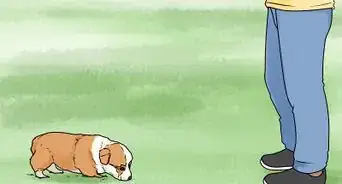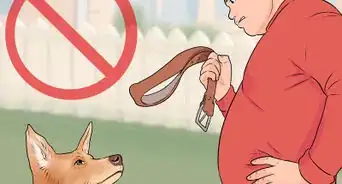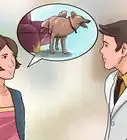This article was co-authored by Belgin Altundag. Belgin Altundag is a Certified Dog Trainer and the Owner of Happy Doggies Day Care/Day Camp in West Hollywood, California. A passionate animal lover, Belgin is knowledgeable about multiple training styles, including obedience training, problem-solving, activity training, and behavior modification. In addition to being an Animal Behavior College’s Certified Dog Trainer (ABCDT), Belgin has also completed the Training Cesar's Way Fundamentals of Dog Behavior and Training Programs 1 and 2 and is certified by the American Red Cross in Cat and Dog First-Aid.
There are 13 references cited in this article, which can be found at the bottom of the page.
This article has been viewed 50,322 times.
Dogs and humans maintain a very special bond. If your dog is distressed, it may make you feel distressed too. Whether it is loud noises, a new environment such as a new home, or an illness that is bothering your pet, you can take steps to make it feel comfortable and loved.
Steps
Comforting Your Dog During Loud Noises
-
1Act nonchalant and relaxed around your dog. While you may feel compelled to comfort your dog with snuggling, treats, and petting, this can actually reinforce the fearful behavior.[1] Instead, do your best to behave normally, treating your dog as you always would, and pretend not to notice her fear.[2]
- This may be difficult and seem cruel, but petting and feeding your dog treats when she is afraid is in fact rewarding the behavior you are trying to stop.[3]
-
2Close blinds or windows. If your dog cannot see (or hear) outside, it may help him to forget about what's happening. Close any windows, curtains, or blinds to help comfort your dog.[4] Take him to an area of the house where he’s less likely to be disturbed.[5]Advertisement
-
3Play calming music. The sound of music may help to drown out distressing sounds. What’s more, studies have shown that classical music can have a very calming effect on dogs in stressful situations.[6]
- Begin with something classical, like Mozart.
- Experiment with different types of music to see what your dog enjoys.
-
4Provide a safe area. If your dog has a crate, allow her to lie in it during the storm. If no crate is available, create a cozy den with blankets and dog items. Place some laundry that smells like you in the safe area to add a soothing effect.[7]
- If using a crate, it may help to drape a blanket over it. Leave the door to the crate open so she doesn’t feel trapped.
- Don’t close your dog in a room. Allow her to have some space without feeling trapped.
-
5Dress your dog in a "thundershirt." A thundershirt is a snug garment designed to target calming pressure points. This has a similar effect to swaddling a baby, and can be very calming to your dog when he's distressed.[8]
- Place the garment on your dog.
- Use the velcro straps to tighten.
- This can also be used to calm him in the car.
-
6Distract your dog. Engage in fun activities that your dog likes. This will keep her mind off the storm and help her to cope.[9]
- Toss a ball.
- Wrestle with chew toys.
- Try playing toys that dispense food or treats.
-
7Use anti-anxiety medication. If your dog’s anxiety is severe, schedule an appointment with his vet to talk about it. Ask about prescription anti-anxiety medication options.[10]
- You may try the dog versions of Xanax, Klonopin, or Diazepam.
- Most commonly, these are used for separation anxiety, but can also be used for severe noise-induced distress.
- Follow the instructions your veterinarian provides.
Bringing a New Dog Home
-
1Give your dog space. When you bring a new dog home, it is important to let her explore her surroundings. Let her wander inside, or in a fenced-in backyard for some time alone. If she has a crate or other bed, allow her to explore it privately. This will help her feel comfortable in her new home.[11]
-
2Provide structure for your dog. Dogs are inherently pack animals. When you bring a new dog into your home, you are inviting him into your pack. Allow him to assimilate by establishing a structure. This will make his transition a comfortable one.[12]
- Feed your dog at the same time(s) each day.
- Walk him at roughly the same time too.
- Be consistent with how you discipline him.
-
3Give your dog her own things. It will provide a great source of comfort to a new pet for her to have her own things. The most essential items are food and water bowls, toys, and places to rest.
- Food and water bowls should not slide around on the ground.
- Toys should be safe for dogs.
- Places to rest can be anywhere for your dog to take a break and be alone, like a crate, dog bed, or just a quiet room with some of her toys.
-
4Introduce him to everyone in the house. It is important for your pet to meet everyone that he will be living with. You don’t want to overwhelm him, so it is best to do these introductions one at a time. Allow him to smell each person and get used to them.
- Try placing one piece of dirty laundry from each member of the household near the dog’s crate or where he sleeps.
-
5Give your dog lots of attention and love. Just like humans, dogs like to feel loved. Studies have shown that pets that receive daily affection have longer life expectancies than those who do not.[13] But petting and playing are not the only ways to show affection to your dog.
- Include your dog in daily activities.
- Allow her to help out with chores by training her to hand you things that you need.
- Praise your dog when her behavior meets your expectations of her.
Comforting a Sick Dog
-
1Find out what is wrong. Take note of your dog’s symptoms, and exactly when they began. Try to be as specific as possible.[14] Once you can determine the problem, you can begin to comfort him.
- Things to look for include: loss of appetite, lethargy, and vomiting.
- Use an online “symptom checker” for dogs to help determine possible causes.
- Call and speak to your vet. Relay the symptoms over the phone and determine the best course of action.
-
2Let her eat grass. If your dog is eating grass, she may have an upset tummy. Eating grass can tickle her throat and tummy and may induce vomiting. This can be very comforting for dog’s with gas or upset tummies.[15]
-
3Keep him hydrated. Especially if your dog has diarrhea, dehydration can be a serious concern. Comfort your dog by offering him plenty of water. [16]
- Try offering him water straight from a hose or faucet, or water with ice cubes. This might spice things up for him and help him to get more water down.
- You can obtain an electrolyte powder for animals from any farm store. Mix this with water for additional prevention or treatment of dehydration.
- You can check to see if your dog is dehydrated by lifting up his lip and examining his gums. If healthy, his gums should be covered with a shiny film.
- If your dog is very dehydrated, get him to the vet right away. Dehydration can lead to organ damage or even death.
-
4Feed her rice. If your dog as an upset tummy, feeding rice to your dog can give her some comfort.[17]
- Boil one cup of white rice in one quart of water, until mushy.
- Drain some of the water, and feed this rice water to your dog. This is both soothing to the tummy and hydrating.
- Feed her some of the mushy, drained rice. You can mash it with a fork for a softer consistency. You can also mix with other food that she likes.
-
5Give him over-the-counter (OTC) medicine. Just like in humans, OTC medicines like bismuth subsalicylate (Pepto-Bismol) can soothe diarrhea or stomach symptoms. [18]
- Give 1 teaspoon per 5 pounds, or 1 tablespoon per 15 pounds. Do this every two hours.
- Ask your vet before giving your dog medicine, especially if they're already on medication.
- Pepto-Bismol should never be given to dogs with bleeding disorders.
- OTC medications should never be used on dogs who are pregnant or nursing.
- Never give Pepto-Bismo to cats!
-
6Take her to the vet. It is not abnormal for a dog to have an upset tummy or other illness once in awhile. However, if your pet is seriously ill, she may need to be seen by a professional.[19] Contact your vet in the event of:
- Vomiting or diarrhea persisting more than 24 hours
- Seizure
- Difficulty breathing
- Moaning with pain
- Trouble urinating
Expert Q&A
-
QuestionWhy is coddling bad for dogs?
 Belgin AltundagBelgin Altundag is a Certified Dog Trainer and the Owner of Happy Doggies Day Care/Day Camp in West Hollywood, California. A passionate animal lover, Belgin is knowledgeable about multiple training styles, including obedience training, problem-solving, activity training, and behavior modification. In addition to being an Animal Behavior College’s Certified Dog Trainer (ABCDT), Belgin has also completed the Training Cesar's Way Fundamentals of Dog Behavior and Training Programs 1 and 2 and is certified by the American Red Cross in Cat and Dog First-Aid.
Belgin AltundagBelgin Altundag is a Certified Dog Trainer and the Owner of Happy Doggies Day Care/Day Camp in West Hollywood, California. A passionate animal lover, Belgin is knowledgeable about multiple training styles, including obedience training, problem-solving, activity training, and behavior modification. In addition to being an Animal Behavior College’s Certified Dog Trainer (ABCDT), Belgin has also completed the Training Cesar's Way Fundamentals of Dog Behavior and Training Programs 1 and 2 and is certified by the American Red Cross in Cat and Dog First-Aid.
Certified Dog Trainer Coddling feeds into the fear your dog is experiencing, and confirms that your dog has something to be worried about. Instead, it's better to calm and firm around your pup.
Coddling feeds into the fear your dog is experiencing, and confirms that your dog has something to be worried about. Instead, it's better to calm and firm around your pup. -
QuestionHow can you train your dog to not be scared of fireworks?
 Belgin AltundagBelgin Altundag is a Certified Dog Trainer and the Owner of Happy Doggies Day Care/Day Camp in West Hollywood, California. A passionate animal lover, Belgin is knowledgeable about multiple training styles, including obedience training, problem-solving, activity training, and behavior modification. In addition to being an Animal Behavior College’s Certified Dog Trainer (ABCDT), Belgin has also completed the Training Cesar's Way Fundamentals of Dog Behavior and Training Programs 1 and 2 and is certified by the American Red Cross in Cat and Dog First-Aid.
Belgin AltundagBelgin Altundag is a Certified Dog Trainer and the Owner of Happy Doggies Day Care/Day Camp in West Hollywood, California. A passionate animal lover, Belgin is knowledgeable about multiple training styles, including obedience training, problem-solving, activity training, and behavior modification. In addition to being an Animal Behavior College’s Certified Dog Trainer (ABCDT), Belgin has also completed the Training Cesar's Way Fundamentals of Dog Behavior and Training Programs 1 and 2 and is certified by the American Red Cross in Cat and Dog First-Aid.
Certified Dog Trainer Try putting on the TV or radio to provide a little background noise. The extra sound may help mask the fireworks.
Try putting on the TV or radio to provide a little background noise. The extra sound may help mask the fireworks. -
QuestionMy English Springer Spaniel is scared of gun shots. What do I do?
 Pippa Elliott, MRCVSDr. Elliott, BVMS, MRCVS is a veterinarian with over 30 years of experience in veterinary surgery and companion animal practice. She graduated from the University of Glasgow in 1987 with a degree in veterinary medicine and surgery. She has worked at the same animal clinic in her hometown for over 20 years.
Pippa Elliott, MRCVSDr. Elliott, BVMS, MRCVS is a veterinarian with over 30 years of experience in veterinary surgery and companion animal practice. She graduated from the University of Glasgow in 1987 with a degree in veterinary medicine and surgery. She has worked at the same animal clinic in her hometown for over 20 years.
Veterinarian While you are desensitizing the dog, try and avoid being around gun shots. If this is unavoidable, then be sure not to comfort the dog, as they will read this as validating their fear. Instead, act nonchalant and do some basic training exercises to show you are in control. In the meantime, download a sound effects CD that has gun shots in it. Play this extremely quietly at home, at a level low enough that the dog doesn't react. Tweak the volume up one notch and reward the dog if it is calm. Every few days, increase the volume one notch so as to very gradually get the dog used to the sounds of gun fire.
While you are desensitizing the dog, try and avoid being around gun shots. If this is unavoidable, then be sure not to comfort the dog, as they will read this as validating their fear. Instead, act nonchalant and do some basic training exercises to show you are in control. In the meantime, download a sound effects CD that has gun shots in it. Play this extremely quietly at home, at a level low enough that the dog doesn't react. Tweak the volume up one notch and reward the dog if it is calm. Every few days, increase the volume one notch so as to very gradually get the dog used to the sounds of gun fire.
Warnings
- Don't let the dog gnaw on your hand, as this can encourage bad biting habits.⧼thumbs_response⧽
- Don't take the puppy near other dogs till he/she has been vaccinated; your dog could get a serious and expensive disease.⧼thumbs_response⧽
- Don't rush your dog. In the heat of the moment, a frightened dog can lash out and attack someone — even a beloved owner. In order to promote its happiness and your safety, exercise patience and control.⧼thumbs_response⧽
References
- ↑ http://www.humanesociety.org/animals/dogs/tips/fear_thunder_loud_noises.html?referrer=https://www.google.com/
- ↑ http://www.humanesociety.org/animals/dogs/tips/fear_thunder_loud_noises.html?referrer=https://www.google.com/
- ↑ Belgin Altundag. Certified Dog Trainer. Expert Interview. 15 July 2021.
- ↑ http://www.arlboston.org/how-to-calm-your-dog-during-a-thunderstorm/
- ↑ Belgin Altundag. Certified Dog Trainer. Expert Interview. 15 July 2021.
- ↑ https://www.cpr.org/2014/01/02/mozart-for-puppies-calming-dogs-with-classical-music/
- ↑ Belgin Altundag. Certified Dog Trainer. Expert Interview. 15 July 2021.
- ↑ http://www.mnn.com/family/pets/stories/does-the-thundershirt-really-work
- ↑ http://www.latimes.com/socal/coastline-pilot/entertainment/tn-hbi-et-0917-my-pet-world-20150917-story.html
- ↑ http://www.latimes.com/socal/coastline-pilot/entertainment/tn-hbi-et-0917-my-pet-world-20150917-story.html
- ↑ Belgin Altundag. Certified Dog Trainer. Expert Interview. 15 July 2021.
- ↑ Belgin Altundag. Certified Dog Trainer. Expert Interview. 15 July 2021.
- ↑ http://www.caninemind.co.uk/dogsneeds.html
- ↑ http://www.petmd.com/dog/dog-symptom-checker
- ↑ http://www.petmd.com/dog/wellness/evr_dg_eating_grass
- ↑ http://www.caninejournal.com/cure-dogs-upset-stomach/
- ↑ http://www.onegreenplanet.org/animalsandnature/great-home-remedies-to-settle-your-dogs-upset-stomach/
- ↑ https://www.petcarerx.com/article/is-it-safe-to-use-pepto-bismol-for-dogs/1512
- ↑ https://www.cesarsway.com/when-to-take-a-dog-to-the-vet-asap/
About This Article
If your dog is scared of loud noises, act as normal as possible and don't offer extra attention. Play calming, classical music and provide a safe area, such as a crate or a den filled with blankets and toys. If your dog is sick, allow grass eating to calm its stomach. Offer water to combat dehydration, and see a vet if your dog has trouble breathing or is vomiting for more than 24 hours. For advice from our reviewer on comforting your dog when there's a new puppy at home, read on.
